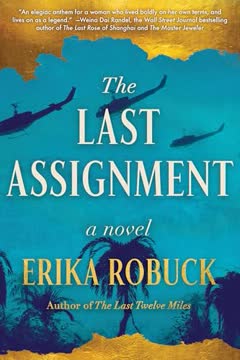Plot Summary
Racing Toward the Front
In the autumn of 1965, war correspondent Dickey Chapelle races her young relatives to the Wisconsin Historical Society, her battered body and combat boots a testament to decades spent chasing conflict. She's donating her life's work—photos, journals, medals—preparing for a future she senses may not include her. Her brother Robert, a veteran, questions her compulsion for danger, but Dickey's heart belongs to the world's front lines. She dreams of capturing the image that will end all wars, her camera a weapon for peace. The children's laughter, the golden leaves, and the campus's tranquility contrast with the violence she's witnessed, underscoring her longing for meaning and her hope that her work will guide future generations away from war's devastation.
Outcast in Her Own Life
In 1954 New York, Dickey is an outsider at her own family gathering, mocked for her unconventional life. Her marriage to Tony, a controlling, unfaithful older man, is crumbling. She's haunted by memories of the Pacific War, where she found camaraderie among Marines—a sense of belonging she's never felt elsewhere. Her mother's disapproval and Tony's betrayals deepen her loneliness. Yet, her beloved Aunt George offers understanding and encouragement, reminding Dickey of her "hopeless hopefulness." The barbs of family and society only strengthen Dickey's resolve to seek purpose and connection on her own terms, even as she aches for acceptance.
Marriage, Betrayal, and Escape
Dickey's marriage unravels as Tony's infidelities and manipulations come to light. Financially strained and emotionally battered, she finally leaves after catching him with another woman. The process is grueling—legal battles, threats, and her mother's shame—but Dickey finds solace in her own apartment, a space of independence. She reconnects with her aunts, who support her decision, and begins to rebuild her life. Training with the Marines at Camp Pendleton, she discovers a new family in uniform, regaining her confidence and sense of worth. The pain of her past lingers, but Dickey's spirit is rekindled by the promise of adventure and the brotherhood of soldiers.
Finding Family in Uniform
Immersed in Marine training, Dickey thrives among young recruits, earning their respect and affection. The esprit de corps fills the void left by her fractured family and failed marriage. She's reaccredited as a war correspondent, her shame from past mistakes lifted. The Marines become her surrogate family, offering acceptance and purpose. Yet, personal losses—her mother's illness and eventual death—remind her of life's fragility. Through grief, Dickey clings to the mission: to bear witness, to document, and to make a difference. Her resilience is forged in the crucible of both war and personal hardship.
War's Aftermath and New Beginnings
The horrors of postwar Europe—insane orphans, shattered cities—leave indelible marks on Dickey's psyche. She channels her pain into advocacy, using her photographs to spur humanitarian aid. A new job with the Research Institute of America and the International Rescue Committee offers stability and a platform for her talents. She finds a kindred spirit in her assistant Stevie, and together they navigate the male-dominated world of Cold War intelligence and relief work. Dickey's optimism and hopefulness, tested by loss and rejection, become her greatest strengths as she prepares for the next conflict.
The Hungarian Revolution's Flames
In 1956, Dickey is drawn to the Hungarian Revolution, determined to document the fight for freedom. She navigates bureaucratic obstacles, secures clandestine support, and joins Pulitzer-winner James Michener at the Austrian border. Together, they help refugees escape Soviet tanks, capturing stories of courage and tragedy. Dickey's empathy and daring earn her trust among the desperate, but her commitment leads to her arrest and imprisonment in a brutal communist prison. Torture, starvation, and psychological torment push her to the brink, but poetry, faith, and the memory of loved ones sustain her. Her eventual release is bittersweet—she's changed, scarred, but unbroken.
Cuba: Revolution and Disillusion
Dickey's next assignment takes her to Cuba, where she embeds with Fidel Castro's rebels. She's captivated by the idealism and camaraderie of the revolutionaries, especially the women fighters. But as victory gives way to purges, show trials, and communist repression, Dickey's faith in the cause is shattered. Friends become enemies, and her reporting earns her both accolades and exile. The loss of her beloved trench knife and the betrayal of ideals mirror her earlier personal losses. Dickey's commitment to truth and justice deepens, even as the world grows more complex and dangerous.
The Price of Bearing Witness
Dickey's relentless pursuit of frontline stories brings both recognition and isolation. She's celebrated for her courage—parachuting with the 101st Airborne, winning prestigious awards—but also faces censorship, professional jealousy, and the pain of being banned from countries she loves. Her reporting on Cuban exiles and anti-Castro commandos in Miami entangles her in dangerous underground networks, testing her ethics and loyalty. The explosion that nearly kills her at sea is a stark reminder of the risks she takes. Through it all, Dickey remains committed to giving voice to the voiceless, even as the personal toll mounts.
The Sea Swallows' Sanctuary
In South Vietnam, Dickey finds a new home among the Sea Swallows, a village of refugees led by the priest-soldier Father Hoa. The hamlet is a rare oasis of peace, faith, and multicultural harmony, defended by both men and women. Dickey becomes part of the family, mentoring children and earning the villagers' trust. The daily threat of Viet Cong attack is ever-present, but the community's resilience and compassion inspire her. Here, Dickey glimpses the possibility of a world healed by forgiveness and understanding, even as war encroaches.
The Heart of Binh Hung
Dickey's time in Binh Hung is marked by deep bonds and devastating losses. She witnesses the transformation of children into warriors, the heartbreak of families torn apart, and the moral ambiguities of guerrilla warfare. The removal of Father Hoa and the fall of the village to communist forces shatter her hopes for a lasting sanctuary. Yet, the courage of the villagers, especially the young women, leaves an indelible mark. Dickey's photographs and stories become a testament to their struggle, even as she mourns the loss of another home.
The Cost of Truth
Back in the U.S., Dickey is honored for her work but feels increasingly out of step with a society turning against the war. She debates student protestors, struggles with the changing nature of conflict, and faces the erosion of public support for the causes she's risked everything to document. The deaths of friends and the rise of the war machine deepen her sense of exile. Yet, she remains driven by the belief that bearing witness matters—that her images and words can still make a difference.
Exile, Return, and Recognition
As Dickey prepares for her last assignment, she reconciles with old adversaries, donates her archives, and reflects on a life spent at the front. She's awarded the Marine insignia she's long coveted, a symbol of belonging and validation. Her relationships—with family, friends, and fellow soldiers—are both her anchor and her sorrow. The world she returns to is more divided than ever, but Dickey's sense of mission endures. She sets out once more, determined to keep her eyes open and her heart engaged, whatever the cost.
The War Comes Home
In Vietnam, Dickey witnesses the transformation of the conflict into a mechanized, impersonal war. The camaraderie and purpose she once found are eroded by bureaucracy, brutality, and the loss of innocence. She intervenes to stop the torture of prisoners, haunted by memories of her own captivity. The lines between good and evil blur, and the toll of violence weighs heavily. Yet, moments of connection—songs, laughter, shared grief—remind her of the humanity that persists amid chaos.
The Machine of War
On her last patrol, Dickey is killed by a booby trap, becoming the first American woman war correspondent to die in action. Her death is swift, her legacy profound. The marines honor her as one of their own, and her work continues to inspire. The field hospital named for her serves as a beacon of hope amid devastation. In the end, Dickey's life is a testament to the power of bearing witness, the cost of truth, and the enduring hope for peace.
The Last Assignment
Dickey's story closes with reflections on the meaning of her life and work. Her archives, photographs, and the memories of those she touched become her true legacy. The world remains fraught with conflict, but the ripples of her courage and compassion extend outward. The question she pursued—can one image, one story, end all wars?—remains unanswered, but her example endures. In the end, Dickey's last assignment is not just a story of war, but of the relentless search for understanding, connection, and peace.
Characters
Dickey Chapelle
Dickey is a fiercely independent, driven woman who finds purpose and belonging on the world's front lines. Scarred by childhood bullying, family misunderstanding, and a toxic marriage, she channels her pain into photojournalism, determined to bear witness to humanity's darkest and brightest moments. Her relationships—with soldiers, refugees, and fellow correspondents—are intense and often fraught, marked by both deep loyalty and inevitable loss. Dickey's psychological complexity is rooted in her need for acceptance, her addiction to danger, and her unwavering hope that her work can make a difference. Over time, she evolves from a "girl reporter" desperate to be first, to a seasoned chronicler of violence, ultimately seeking reconciliation and peace in a world that rarely offers either.
Tony Chapelle
Tony is Dickey's older, charismatic, and deeply flawed husband. Initially her mentor and savior, he becomes a controlling, unfaithful, and emotionally abusive partner. His need for validation and his inability to accept Dickey's independence lead to repeated betrayals and public humiliations. Tony's psychological hold on Dickey is both a source of her suffering and a catalyst for her eventual liberation. Even after their separation, his presence lingers, a reminder of the personal costs of Dickey's chosen path.
Aunt George
Aunt George is Dickey's beloved aunt and namesake, a bohemian poet who offers unconditional love and understanding. She encourages Dickey's ambitions, provides refuge during crises, and serves as a counterpoint to the judgmental voices in Dickey's life. Her own experiences with loss and resilience mirror Dickey's journey. Aunt George's death is a profound loss, but her wisdom and spirit continue to guide Dickey, especially in moments of doubt and despair.
Stevie Blick
Stevie is Dickey's assistant, confidante, and emotional ballast. Practical, witty, and fiercely protective, she helps Dickey navigate the challenges of a male-dominated profession and the chaos of war reporting. Their relationship is marked by deep affection, occasional exasperation, and mutual respect. Stevie's grounded perspective and unwavering support provide Dickey with a sense of home and stability, even as the world around them shifts.
Father Hoa
Father Hoa is the leader of Binh Hung, a refugee village in South Vietnam. A man of faith and action, he embodies the possibility of reconciliation and the power of community. His dual roles as spiritual guide and military strategist reflect the complexities of war and the struggle for justice. Father Hoa's compassion, wisdom, and eventual displacement mirror the broader tragedy of Vietnam. His teachings on forgiveness and peace leave a lasting imprint on Dickey's soul.
Bernie Yoh
Bernie is a Chinese Nationalist officer and intelligence adviser, instrumental in connecting Dickey to Father Hoa and the Sea Swallows. Pragmatic, resourceful, and deeply committed to the anti-communist cause, he navigates the shifting alliances and moral ambiguities of the Cold War. Bernie's friendship with Dickey is built on mutual respect and shared purpose, though he is haunted by the limits of what can be achieved through force alone.
Tien
Tien is a Sea Swallow in Binh Hung, embodying the next generation's courage and vulnerability. His journey from eager recruit to battle-hardened survivor reflects the costs of war on youth and innocence. Tien's relationships—with his family, with Dickey, and with his community—highlight the stakes of the conflict and the enduring power of love and loyalty.
Felipe Vidal Santiago
Felipe is a Cuban naval officer turned revolutionary, then anti-Castro commando. His idealism, bravery, and eventual disillusionment mirror the arc of the Cuban Revolution itself. Felipe's partnership with Dickey in Miami's underground is marked by camaraderie, shared risk, and growing darkness. His execution by Castro's regime is a devastating blow, underscoring the personal costs of political struggle.
Henri Huet
Henri is a French-Vietnamese photojournalist who becomes Dickey's companion in Southeast Asia. His empathy, professionalism, and personal stake in the conflict provide Dickey with both support and challenge. Henri's fate—killed in action years after Dickey—serves as a reminder of the dangers faced by those who bear witness.
Robert Meyer
Robert is Dickey's younger brother, a veteran and academic who both admires and fears for his sister. His pragmatic concerns and emotional distance reflect the tension between familial love and incomprehension. Robert's presence grounds Dickey, offering moments of connection and conflict that illuminate her deepest motivations.
Plot Devices
Nonlinear, Epistolary, and Immersive Structure
The narrative unfolds through a mix of present-tense action, flashbacks, letters, telegrams, diary entries, and transcripts. This structure mirrors the fragmented, chaotic nature of war and memory, allowing readers to experience Dickey's life as a series of vivid, interconnected moments. The use of real and fictionalized documents blurs the line between history and storytelling, immersing readers in the immediacy of events while providing intimate access to Dickey's thoughts and feelings. The nonlinear approach heightens suspense, reveals character development organically, and underscores the cyclical nature of conflict and trauma.
Foreshadowing and Recurring Motifs
The narrative is rich with foreshadowing—Dickey's early sense of impending death, the recurring image of the bogeyman, and the motif of the "picture to end all wars." Objects like her trench knife, pearl earrings, and photographs serve as tangible links to her past and her evolving identity. The repetition of prayers, songs, and cultural rituals across different settings highlights the universality of suffering and resilience. These devices create emotional resonance and thematic cohesion, inviting readers to reflect on the deeper meanings beneath the surface action.
Juxtaposition of Public and Private Battles
The story continually contrasts Dickey's internal struggles—loneliness, shame, the search for belonging—with the external wars she covers. Her personal relationships, especially with family and fellow correspondents, are as fraught and consequential as the battles she photographs. The blurring of boundaries between observer and participant, victim and survivor, underscores the psychological toll of bearing witness. This device invites readers to consider the costs of truth-telling and the ways in which private wounds shape public action.
Thematic Use of Exile and Homecoming
Exile—literal and metaphorical—is a constant in Dickey's life. Banned from countries, estranged from family, and always on the move, she is both a seeker and a fugitive. Moments of homecoming are bittersweet, marked by loss and the realization that true belonging may be unattainable. The motif of the surrogate family—found among soldiers, villagers, and fellow exiles—offers both solace and sorrow. This device deepens the emotional arc, highlighting the tension between the desire for roots and the demands of vocation.
Analysis
Erika Robuck's The Last Assignment is a sweeping, emotionally charged portrait of a woman who lived—and died—at the intersection of history's most turbulent conflicts. Through Dickey Chapelle's eyes, the novel explores the costs and contradictions of bearing witness: the exhilaration of purpose, the ache of exile, and the relentless toll of violence on body and soul. Robuck's adaptation foregrounds the psychological complexity of her protagonist, using a nonlinear, immersive structure to draw readers into the immediacy of war and the intimacy of personal struggle. The book interrogates the myth of the heroic correspondent, revealing the loneliness, addiction to danger, and longing for connection that drive Dickey's choices. At its core, the novel is a meditation on the power and limits of storytelling—can one image, one act of truth-telling, end all wars? Robuck suggests that while the answer may be elusive, the attempt itself is an act of hope. The lessons are clear: courage is not the absence of fear but the persistence of purpose; forgiveness is the only antidote to the cycle of violence; and the search for meaning, though fraught with loss, is what makes a life extraordinary. In an age still marked by conflict and division, Dickey's story is both a cautionary tale and a call to bear witness—to keep our eyes open, our hearts engaged, and our hope alive.
Last updated:
Review Summary
The Last Assignment is a compelling historical fiction novel about Dickey Chapelle, a trailblazing female photojournalist and war correspondent. Readers praise Robuck's vivid storytelling, bringing Chapelle's courageous life to the forefront. The book covers Chapelle's experiences in various conflicts, including Hungary, Cuba, and Vietnam. Many reviewers appreciate learning about this remarkable woman and her contributions to journalism. While some found the pacing slow at times, most highly recommend the book for its portrayal of a fearless woman who risked everything to document the realities of war.
Similar Books
Download PDF
Download EPUB
.epub digital book format is ideal for reading ebooks on phones, tablets, and e-readers.











